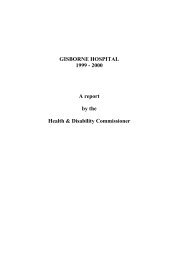09HDC01565 - Health and Disability Commissioner
09HDC01565 - Health and Disability Commissioner
09HDC01565 - Health and Disability Commissioner
Create successful ePaper yourself
Turn your PDF publications into a flip-book with our unique Google optimized e-Paper software.
<strong>Health</strong> <strong>and</strong> <strong>Disability</strong> <strong>Commissioner</strong><br />
1996 <strong>and</strong> May 2003, with several more as a trainee. Between June 2003 <strong>and</strong> October<br />
2009, he performed five of the 26 decompressions carried out at CDHB‘s<br />
neurosurgical unit. 32<br />
130. Dr E also notes that he has worked at four neurosurgical units (two in New Zeal<strong>and</strong>,<br />
two overseas) <strong>and</strong> in none of these was it routine to place patients who had had Chiari<br />
decompression surgery in intensive care postoperatively.<br />
131. In response to Mrs C‘s concerns about her son straining <strong>and</strong> vomiting postoperatively,<br />
Dr E notes that straining, coughing, <strong>and</strong> vomiting are very common in patients who<br />
have had posterior fossa surgery, <strong>and</strong> this cannot always be prevented. He states that<br />
there is no benefit to keeping patients in bed for 72 hours after surgery. Patients are<br />
mobilised early <strong>and</strong> allowed to sit up <strong>and</strong> eat once swallowing is deemed co-ordinated<br />
after oral sips, <strong>and</strong> the patient is fully awake.<br />
132. Dr E states that his subspecialty work revolves around complex neurovascular <strong>and</strong><br />
tumour work, <strong>and</strong> a significant portion of these are related to the brainstem. He does<br />
not regard Chiari decompression as a highly complex procedure with an extreme to<br />
very high risk, but accepts that there is some risk to neurological function <strong>and</strong> a very<br />
small risk of fatality. In his experience, the most common complications are wound<br />
complications, followed by early postoperative headaches <strong>and</strong> failure to resolve<br />
presurgical symptoms.<br />
133. Dr E notes the changes made following the RCA <strong>and</strong> consultation with other<br />
neurosurgical units. He states that since these events, he has made a point of<br />
requesting an 18–24 hour period of ECG or oxygen saturation monitoring, even if the<br />
patient seems completely well, fully conscious, <strong>and</strong> demonstrates no obvious features<br />
that cause concern.<br />
Additional information from Dr F<br />
134. Dr F had two <strong>and</strong> a half years‘ general neurosurgical experience prior to these events.<br />
He had started work as a neurosurgical trainee at the hospital in December 2008. Dr F<br />
explains the purpose of the training programme, noting that supervision is a crucial<br />
component of this <strong>and</strong> that his work was ―continuously supervised‖. Dr F states that<br />
while he had been involved in the care of other patients having upper cervical<br />
laminectomies <strong>and</strong> posterior fossa decompression previously, his experience in<br />
managing Chiari malformations prior to the time of Mr A‘s surgery was ―limited‖. He<br />
noted that the fact he was the assistant <strong>and</strong> not the surgeon for the operation reflected<br />
his level of experience.<br />
135. Dr F notes the changes that had been implemented following the RCA. With regard to<br />
his own practice, he states that now ensures that all risks <strong>and</strong> complications that he<br />
has discussed are fully documented.<br />
32 Dr E noted that within the neurosurgical unit there are sub-specialties, <strong>and</strong> the majority of<br />
decompressions are done by his colleague who specialises in pediatric <strong>and</strong> pituitary/acoustic work.<br />
5 September 2012 24<br />
Names have been removed (except Canterbury DHB <strong>and</strong> the experts who advised on this case) to<br />
protect privacy. Identifying letters are assigned in alphabetical order <strong>and</strong> bear no relationship to the<br />
person’s actual name.
















